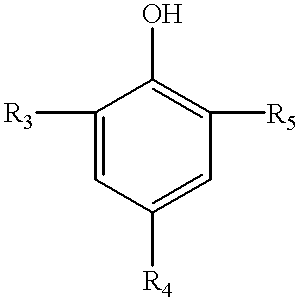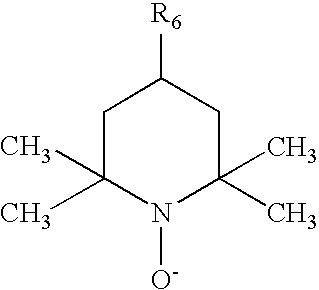Compositions for shortstopping free radical emulsion polymerizations and stabilizing latices made therefrom
a free radical emulsion and polymerization technology, applied in chemical inhibitors, chemistry apparatus and processes, other chemical processes, etc., can solve the problems of increasing volatility and water solubility, not performing well as shortstoppers, and most nitroxides and phenolic compounds are costly or toxi
- Summary
- Abstract
- Description
- Claims
- Application Information
AI Technical Summary
Benefits of technology
Problems solved by technology
Method used
Image
Examples
Embodiment Construction
The experiment involves emulsion polymerization processes of preparing SBR latexes where various free radical scavengers are evaluated as a shortstopper for the SBR emulsion processes and as a stabilizer for the corresponding SBR latexes. The polymerization is performed at 10.degree.-12.degree. C. and is based on the following recipe:
In one experiment, the polymerization reactor is discharged at a conversion of .about.40%, and the SBR latex is allocated to several containers. Various shortstoppers are added to these containers, and the solid content in these latexes are measured with time. Table 1 lists the conversion (calculated from the solid content) with time for six latex samples. In general, the results show that DEHA, DEHA / SDDC, and DEHA / DBHA all exhibit excellent performance as shortstopper for the emulsion process of SBR.
In another experiment, the polymerization is shortstopped at a conversion of .about.60% using 350 ppm DEHA. Various stabilizers are then added to such late...
PUM
| Property | Measurement | Unit |
|---|---|---|
| hydrophilic | aaaaa | aaaaa |
| composition | aaaaa | aaaaa |
| hydrophobic | aaaaa | aaaaa |
Abstract
Description
Claims
Application Information
 Login to View More
Login to View More - R&D
- Intellectual Property
- Life Sciences
- Materials
- Tech Scout
- Unparalleled Data Quality
- Higher Quality Content
- 60% Fewer Hallucinations
Browse by: Latest US Patents, China's latest patents, Technical Efficacy Thesaurus, Application Domain, Technology Topic, Popular Technical Reports.
© 2025 PatSnap. All rights reserved.Legal|Privacy policy|Modern Slavery Act Transparency Statement|Sitemap|About US| Contact US: help@patsnap.com


